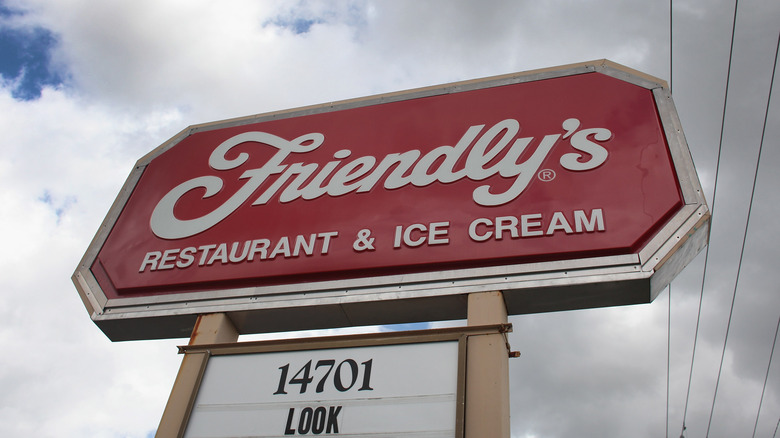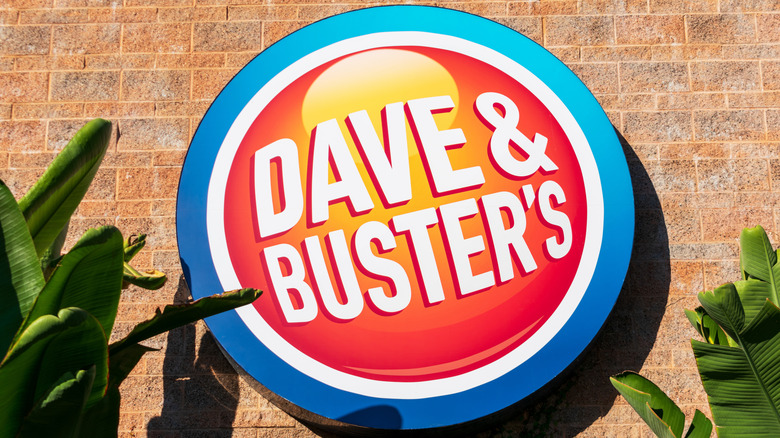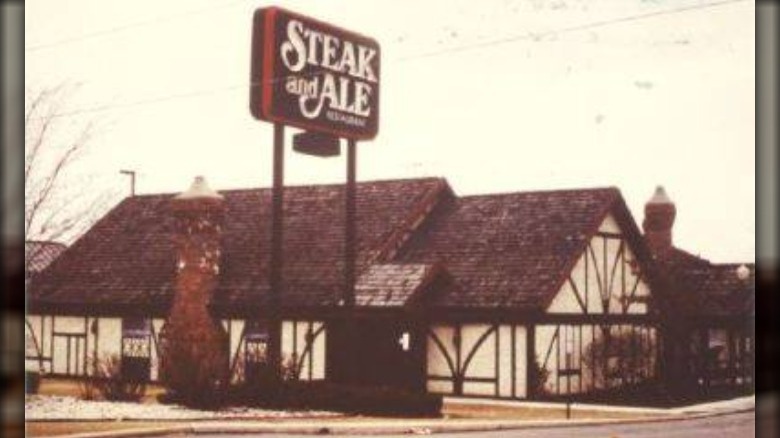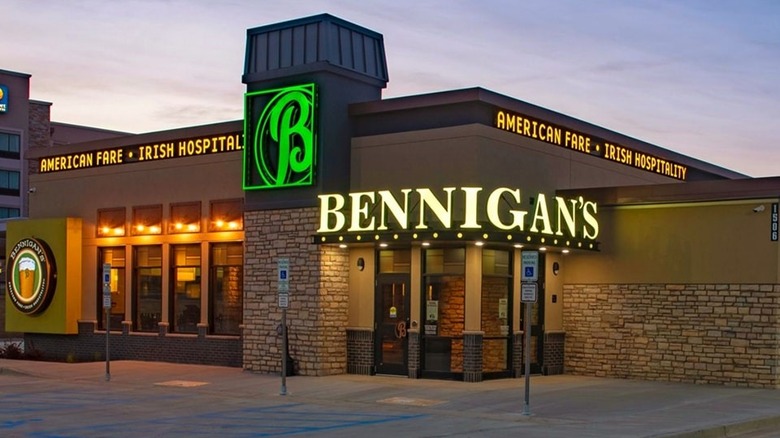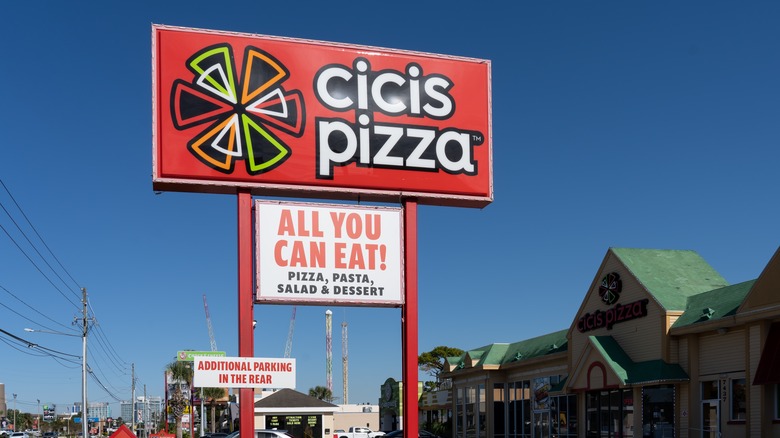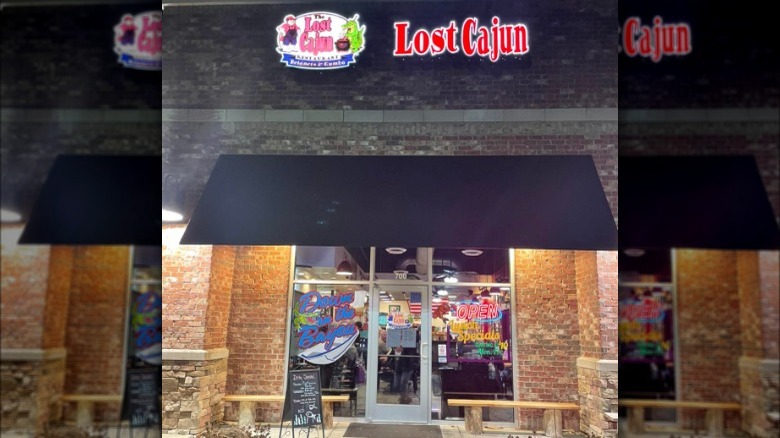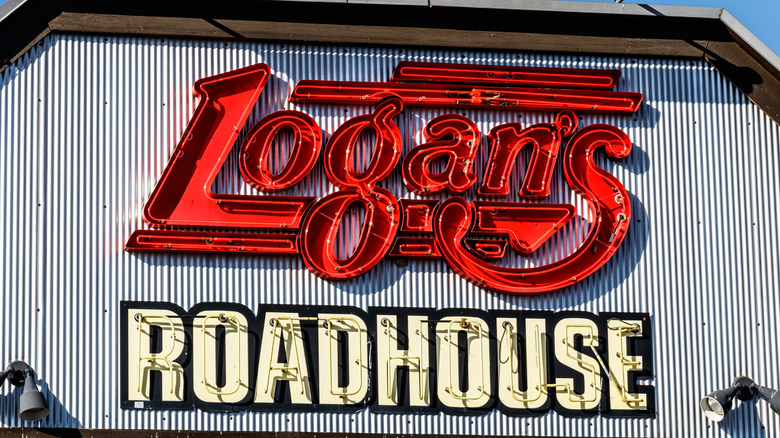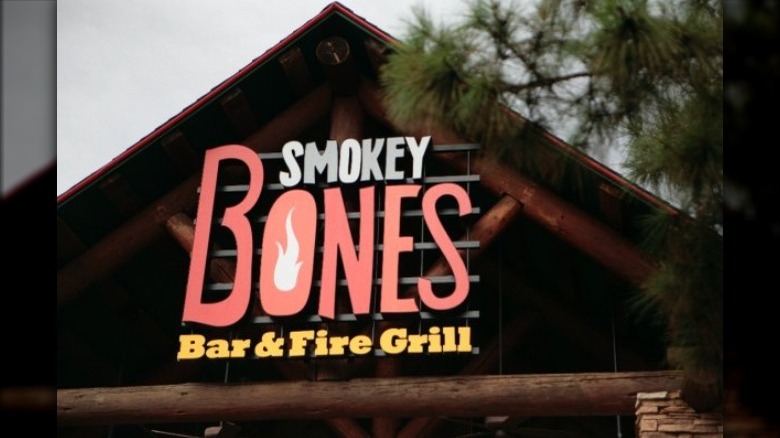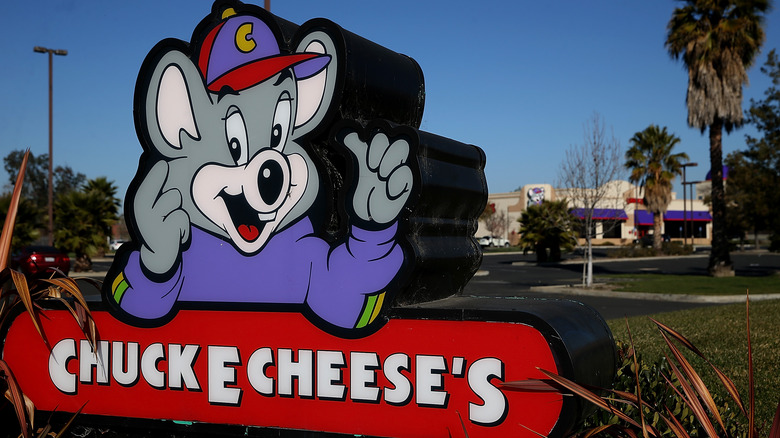Restaurant Chains Making A Comeback After Going Broke
The days when restaurant chains going broke was major news are over—COVID-19 made sure of that. Dozens of chains were brought to their financial knees from the lack of business brought on by the pandemic. Particularly hard hit were fast-casual restaurants, which have always relied heavily (or exclusively) on customers dining in person. But not all the blame belongs to COVID-19. Many chains were struggling financially long before anyone, anywhere had even heard the word coronavirus.
Regardless of the cause, a very long list of restaurant chains have fallen on dire financial times in recent years. These lean periods usually culminated in bankruptcies. But while some restaurants opted to simply turn off the lights, many fast-food and fast-casual chains would not go quietly into the night. Instead, these intrepid brands crawled their way out of the red and into greener pastures. That's right—many of your favorite restaurant chains that had been left for dead are back on the comeback trail. Along the way, they have evolved in order to diversify revenue streams and, most importantly, provide an improved customer experience.
From two major eater-tainment chains and a nearly century-old, family-focused restaurant to a trio of popular pizza joints and a cajun brand based out of Colorado, here are some of the restaurant chains making a comeback after going broke.
California Pizza Kitchen
Few chains were harder hit by COVID-19 than California Pizza Kitchen. In the blink of an eye, dine-in sales dropped nearly 80%, forcing the company to close the roughly 50 locations that didn't offer off-site dining. Just a few months later, California Pizza Kitchen filed for Chapter 11 bankruptcy. The owners tried to sell but didn't even receive any qualified bids. Instead, they went to work getting out from under $400 million debt.
California Pizza Kitchen emerged from bankruptcy in November with $220 million of debt off its books, ready to turn things around. To spur on its revitalization, the brand focused on continuing its menu innovation, investing in technology, and expanding its off-premises business. The changes helped sales climb back to pre-COVID levels the very next year.
One of the company's main priorities now is expansion. In December 2021, California Pizza Kitchen announced the launch of its first-ever domestic franchise program. "For the first time in our 35-year history, we're eager to engage new domestic franchisee partners that share a passion for creating memorable dining experiences and expand our reach to bring CPK to even more diners nationwide," Giorgio Minardi, the brand's executive vice president of global development & franchise operations, said in a statement. The company also has eyes on expanding its global reach. In March of 2022, California Pizza Kitchen announced plans to open new locations in Costa Rica and Chile, which would increase its international restaurant count to approximately 50.
Golden Corral
From fast-food joints to fine-dining establishments, every type of restaurant faced hardships during the COVID-19 pandemic. But because of their use of shared surfaces, buffet-style eateries like Golden Corral faced a particularly challenging road to regaining business even after restaurants were allowed to reopen. The drop in business forced the chain's two largest franchisees to file for bankruptcy. "It was some dark days very early on," Golden Corral CEO Lance Trenary told FSR Magazine. "We knew that our segments—that our company in particular—was going to be under enormous pressure."
Golden Corral had to find new ways of getting food to its customers. A variety of methods were introduced, including cafeteria-style dining and "buffet-to-your-table" service. More notably, Golden Corral added drive-thru and delivery options, and even developed its first virtual brand called Homeward. "Anything that we can do to basically scream that, hey, Golden Corral is not just to find an experience, we have all these other options," Trenary said. "So, we're really trying to build that part of our business, and we think that's going to be a forever thing."
By the summer of 2022, Golden Corral was performing better than before the pandemic, with same-store sales increasing 3%-5% from 2019. The impressive turnaround was enough to earn Trenary the prestigious Gold Plate Award from the International Foodservice Manufacturers Association. "The last two years have been so difficult," he said in a press release. "To have enjoyed the turnaround that we have had has been everything."
Friendly's
Friendly's was founded in 1935 in the midst of the Great Depression, so it knows a thing or two about surviving tough times. The chain has needed every bit of that fortitude in recent years. Friendly's has filed for bankruptcy twice in just over a decade, first in 2011 and then again in 2020. From the outside, these financial dips could be viewed as anomalies caused by the Great Depression and COVID-19 pandemic, respectively. But the truth is that Friendly's has been in a financial freefall for the better part of this century. Case in point: The company was sold in 2007 for more than $337 million. When new ownership purchased the chain in 2020, it cost them less than $2 million.
But finally, things are looking up for Friendly's, thanks in large part to its new owner, Acmi Partners Group, which has breathed new life into the once-struggling restaurant chain. New leadership began the revitalization process with changes to the menu. In early 2021, Friendly's brought back an all-star lineup of menu items and began a practice of offering a new ice cream flavor every quarter. It also introduced a new loyalty program.
The brand isn't just sticking to what worked in the past, however. Like every restaurant chain, it has had to reinvent itself. This has taken the form of Friendly's Café, a new fast-casual model the company debuted in 2022. Friendly's also began opening ghost kitchens and incorporating virtual brands inside its restaurants.
Dave & Buster's
Just three short years ago, it appeared that the writing was on the wall for Dave & Buster's—and the message wasn't good. In the COVID-19 summer of 2020, the eater-tainment chain announced plans to layoff 1,300 employees. Not long after, the company warned that bankruptcy may be next.
But alas, Dave & Buster's had a brighter future in store than most could have imagined. After successfully avoiding bankruptcy, the chain regrouped with a new business plan. This included acquiring exclusive arcade games, developing new food and drink menus, adding in-store tech features, and offering third-party delivery. For its adult customers, the chain brought in nationally known DJs to play during happy hour and partnered with the UFC and WWE to televise the leagues' events. "We have so much opportunity here that are clearly things that we could do that anybody coming in would say, 'Wow, that makes sense. That makes sense,'" Dave & Buster's interim CEO Kevin Sheehan said on a conference call (via FSR Magazine). "So we're running on all of those, but also being thoughtful not to take away from the great opportunity of a new person coming in."
The moves paid off as well as, if not better than Dave & Buster's could have hoped. In the first quarter of 2022, Dave & Buster's brought in a record $451.1 million. For context, the brand recorded $363.6 million in sales during the same time period in 2019.
Steak and Ale
Steak and Ale has a storied history that dates back to the 1960s. Positioning itself as an upscale steakhouse offering reasonable prices, the brand helped pioneer casual dining. That all came to an end in July 2008, when the company filed bankruptcy. Unlike many other chains that continue to operate through bankruptcy proceeding, Steak and Ale immediately closed all 58 of its restaurants.
The brand laid dormant for seven years until Paul and Gwen Mangiamele came along. Through their Legendary Restaurant Brands company, the husband-and-wife team purchased the rights to the chain's brand, recipes, and intellectual property. That began what would turn out to be an eight-year process of getting Steak and Ale back up and running. "You've gotta be very disciplined, especially as a franchisor," Paul Mangiamele told Restaurant Business Online. "It's been very slow but very deliberate and hopefully very intelligent." In January 2023, Legendary Restaurant Brands agreed to a 15-restaurant development pact with franchise operator Endeavor Properties. The first location is set to open later this year in the Minneapolis suburbs.
Future diners can expect a similar experience to the Steak and Ale of old, but with some noticeable differences. Chief among them—the restaurants will be smaller in size but feature a wider range of food and beverage offerings. "People harken to the days when people can have a great experience and don't have to spend a lot of money," Mangiamele said. "The evolution of the affordable steakhouse category is ready for the reintroduction."
Bennigan's
When Steak and Ale's parent company S&A Restaurant Corp. filed for bankruptcy in 2008, it also affected the company's other casual-dining chain: Bennigan's. In the blink of an eye, all 150 corporate-owned locations of the Irish-themed chain were closed. Many of the roughly 130 franchise outposts would shut their doors not long after, leaving Bennigan's with just 15 restaurants to its name.
Just like Steak and Ale, however, Bennigan's was pulled from the brink by Legendary Restaurant Brands, which purchased the chain in 2015. Three years later, the brand opened new restaurants in Steubenville, Ohio; Mandan, North Dakota; and Monahans, Texas. These off-the-beaten-path locations might seem like less-than-ideal places to set up shop, but they were chosen as part of Bennigan's strategy of focusing on smaller markets. Not only can Bennigan's operate with less overhead in these cities, the restaurants are also more of an attraction here. "If I open a Bennigan's in Manhattan, it's ho-hum, another restaurant," Legendary Restaurant Brands CEO Paul Mangiamele said. "You open in Monahans, Texas, and it's the biggest event of the century."
Early signs indicated the strategy is working. The three new restaurants were earning twice the revenue of traditional Bennigan's locations despite being half their size. "We have distilled 42 years of experience into a system that delivers proven results for the brand and resonates with the communities we serve," Mangiamele said (via RestaurantNews.com). "As a result, Bennigan's is now flourishing in smaller markets that so many national brands ignore."
Sweet Tomatoes
Just like Steak and Ale, casual-dining chain Sweet Tomatoes (or Souplantation if you're in California) wasn't just broke—it was completely out of business. The restaurant's parent company Garden Fresh Restaurants filed of bankruptcy in 2020, shutting down all of its Sweet Tomatoes locations in the process. Three years later, it appears the deceased chain has regained a heartbeat.
In March, real estate company CBRE announced that it had leased out a 7,000-square-foot Tucson, Arizona building that previously housed a Sweet Tomatoes restaurant for more than 20 years. The new tenant, a company called ST Three LLC, said it planned to revive the restaurant and had already secured the brand's intellectual property and hired some former Sweet Tomatoes operators. "[The tenant] indicated the concept [Sweet Tomatoes] had and continues to have a strong following with patrons still active on Facebook and Instagram sites," CBRE's Nancy McClure said in a statement.
The real estate company indicated ST Three planned to open the restaurant in the coming months, but there was no news as to whether it would follow the same buffet-style Sweet Tomatoes was previously known for. Surely to the demise of fans, there was also no information given about the possibility of future Sweet Tomatoes restaurants opening. Restaurant Business Online reported that the Tucson location will act as a test case for the resurrected brand.
CiCis Pizza
In 2009, CiCis Pizza boasted a whopping 600 locations to its name. That number would ultimately prove to be the chain's high mark. Over the next decade, the pizza company's footprint steadily declined. By 2021, Cicis was down to just 300 restaurants. The precipitous drop in business forced the pizza chain to file for bankruptcy that same year.
The company received a lifeline in the form of D&G Investors, a newly created investment firm that agreed to buy the brand out of bankruptcy. "We are doing well," Cicis President Jeff Hetsel told Franchise Times in 2023. "We've really bounced back from COVID. It was a little dark there for a while, but we were able to put together a great team and a great plan and found a great partner. We're starting to get some traction."
The new owners helped improve operations, recipes, and advertising. The most notable difference, meanwhile, is also the hardest to miss. CiCis restaurants now include game rooms exponentially larger than those found in the traditional stores. "I just put $180,000 worth of games into my store in Fort Worth, and my game revenue doubled," Hetsel said. "It's been unbelievable."
These changes have been a boon for CiCis. In 2022, same-store sales increased 31% from the year before. The chain even performed better than it had in the final pre-COVID year of 2019.
The Lost Cajun
The Lost Cajun was founded in Frisco, Colorado in 2010 by Louisiana native Raymond Griffin. Its "exotic" cuisine was an immediate hit with residents of the Centennial State who would wait in lines that wrapped around the building. The success led Griffin to begin franchising a few years later. This is when things went south. Griffin admits that the chain simply expanded too rapidly for its own good. "Too fast growth is too fast growth," Griffin told FSR Magazine. "You can't do it well."
The Lost Cajun eventually grew to 25 stores in 2018 but started closing restaurants that same year. Things got worse once the pandemic hit, forcing the chain to declare bankruptcy in March 2021. The company emerged from bankruptcy a few months later with a new lease on life ... and a new strategy. Griffin initially opened the restaurant to foster community and was thus not focused on delivery. Before COVID-19, off-site sales accounted for less than 10% of revenue. After learning how to keep food quality high during transportation, delivery sales grew to roughly 35%.
There have been other signs of a strong comeback for the chain. Despite opening in the midst of the pandemic, a Canon City, Colorado location was an instant success. Not long after, the chain expanded to California. "He said, 'I am not going to be deterred,'" Griffin recalled the California store's franchisee saying. "'I am going to open a Lost Cajun because I know it's going to be wildly successful.'"
Logan's Roadhouse
Things were looking bleak for Logan's Roadhouse back in March 2020. After closing 37 underperforming stores, parent company CraftWorks Holdings filed for Chapter 11 bankruptcy with a plan to sell its 261 company-owned restaurants. The COVID-19 pandemic threw a wrench in those plans, however, forcing CraftWorks to shutter those locations instead and furlough its roughly 18,000 employees. CraftWorks was headed toward Chapter 7 bankruptcy, which would have forced it to surrender all its assets and cease operations.
A few months later, the company received a lifeline. In June, SPB Hospitality agreed to purchase CraftWorks' portfolio of restaurants, including Logan's Roadhouse. Under new leadership, Logan's came back to life—quickly. By July, 103 of the chain's 113 locations were back open.
SPB's strategy focused on trimming the steakhouse's menu, closing stores in poor-performing markets, and increasing off-site sales. It's been working better than most could have guessed. In 2021, the chain recorded $417 million in sales across 136 stores. That marks a roughly $160 million increase from the year prior, according to Restaurant Business Online. For context, Logan's brought in $496 million in the pre-COVID year of 2019, but that was done with a footprint of 204 restaurants.
"We've got a really dedicated group of people that are focused specifically on their concepts," SPB CEO Marc Buehler told FSR Magazine in regard to Logan's Roadhouse and its sister chains. "They're excited about what the challenges are in front of them and where we can go with these brands."
Smokey Bones
Unlike many of the restaurants on this list that can point to the COVID-19 pandemic as the root of their money woes, problems for Smokey Bones started years earlier. The barbecue chain was founded in 1999 and eventually grew to include nearly 130 restaurants. But with business dwindling, parent company Darden shut down 54 locations in 2007 and sold the remaining stores.
The brand continued to struggle under new ownership, recording steadily declining revenue from 2015-2018. Things finally took a turn the following year when former Long John's Silver and Sonic executive James O'Reilly took over as CEO in 2019. Smoky Bones also retained the services of Doug Zeif, the consultant who originally developed the brand. The new leadership reshaped the chain's menu and introduced two new virtual brands, the Burger Experience and Wing Experience. Smokey Bones has since added two more digital brands, the barbecue-focused Bowl Market and chicken-centric Tender Box.
All this new business has helped a chain that once relied solely on brick-and-mortar restaurants. Restaurant Business Online estimates it brought in $125 million in revenue across 64 stores in 2020. The very next year, it increased sales to $186 million despite having three fewer restaurants. "We have been believers in our virtual restaurant business ever since they've become a meaningful part of our revenue stream," O'Reilly told FSR Magazine. "And we've learned over the last few years how to continuously optimize them and improve the guest experience."
Chuck E. Cheese
Oh, how quickly things can change. In 2019, Chuck E. Cheese recorded more than $900 million in sales. The very next year, it temporarily closed its 775 locations and filed for bankruptcy. "Unfortunately, we didn't have the strength in our balance sheets to survive the pandemic," David McKillips, CEO of parent company CEC Entertainment, told the IAAPA.
The previous year's success, however, was a clear indicator that the demand was still alive. Chuck E. Cheese is one of the largest pizza companies in the world but as opposed to other pizza brands, the chain derived almost none of its revenue from delivery and takeout. Chuck E. Cheese just needed a new way to reach its customers.
It found that way by becoming one of the first national companies to launch a new brand through ghost kitchens. Pasqually's Pizza & Wings is a delivery-only business that operates out of Chuck E. Cheese kitchens but offers a distinct pizza, different from the one you'd get at the eater-tainment restaurant. To get customers safely back inside its restaurants during the pandemic, Chuck E. Cheese also invested heavily in technology improvements, including the introduction of an e-ticket platform and the development of a new phone app.
This evolution points to a brighter future for Chuck E. Cheese. "The brand has been able to reinvent itself over the decades," McKillips says. "We're ready for the next generation of Chuck E. Cheese—for today's kids who want entertainment in a bit of a different way."



